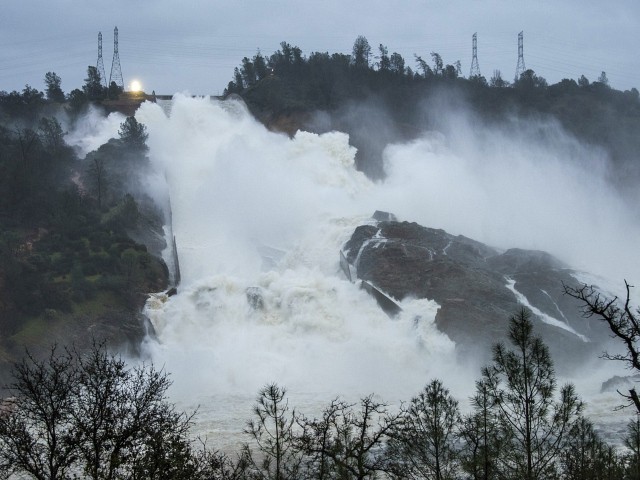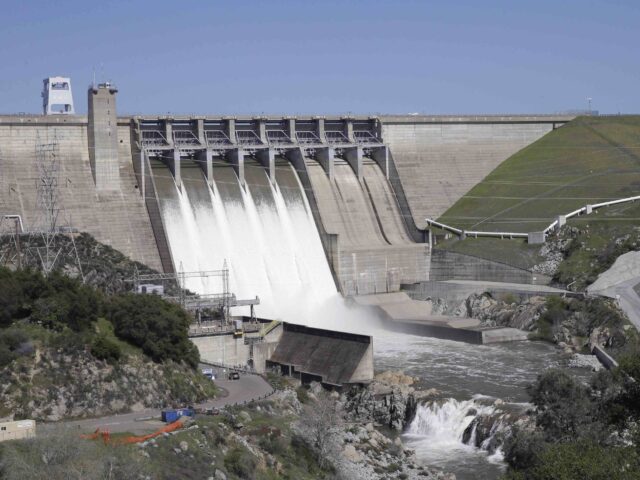California’s dams are filling up, thanks to the winter’s heavy storms — but soon the state’s dams will be opening their floodgates to prevent overflowing.
The fact that so much of the water that has been collected thus far will be allowed to run out to sea may shock many Californians, who became more away of water scarcity during the intense three-year drought that just ended for much of the state.
Many Californians are critical of judicially-enforced mandates that require California’s dams to allow let water out to sea — even in dry years — to protect endangered species of fish downstream, such as the Delta smelt.
But this time, the reason is different.
California’s dams often open their floodgates at the beginning of spring, even in relatively dry years, because of the amount of water that flows into the dams as the winter snowmelt runs off the Sierra Nevada mountains.
If the dams do not have enough spare capacity to capture the snowmelt, there is a risk that they may fail — as nearly happened to the Oroville Dam in 2017, when the spillway was destroyed at the nation’s highest dam.

OROVILLE, CA: In this handout provided by the California Department of Water Resources (pixel.water.ca.gov), Water continues to move down the damaged spillway at Oroville Dam with an outflow of 80,000 cubic feet per second (cfs) on on February 17, 2017 in Oroville, California. Last weekend overflow waters from the emergency spillway eroded much of the area below the spillway. The California Department of Water Resources continues to examine and repair the erosion with more than 125 construction crews working around the clock, and placing 1,200 tons of material on the spillway per hour using helicopters and heavy construction equipment at the Butte County site. (Photo by Brian Baer/ California Department of Water Resources via Getty Images)
When the emergency spillway, too, began to crumble, officials evacuated hundreds of thousands of people from towns downstream, and there were fears of a catastrophic dam failure that would flood the region.
Still, Californians may be shocked to see the dams opening their floodgates, after so much recent talk about the state’s lack of water storage capacity. But ongoing storms may force the issue. The Los Angeles Times reports:
At least 10 rivers are forecast to overflow from the incoming “Pineapple Express” storm, which is expected to drop warm, heavy, snow-melting rain as it moves from the Central Coast toward the southern Sierra beginning Thursday night into Saturday.
…
The conditions are in some ways akin to those that led to a near catastrophic failureof the Oroville Dam in 2017, when heavy rains damaged an emergency spillway and threatened to send floodwaters down to communities below.
Officials on Thursday said there is no danger of a similar event now since the spillway has been reconstructed with several feet of thick concrete. However, the second-largest reservoir in California is about 60 feet below its maximum elevation, said Ted Craddock, DWR’s deputy director of the State Water Project, and operators have begun releasing water to ensure room for incoming flows.
On Friday, the San Francisco Chronicle notes, several ski resorts in Lake Tahoe closed, and flood advisories were issued in Santa Clara and Santa Cruz counties. Several rivers are in danger of overflowing their banks.
Joel B. Pollak is Senior Editor-at-Large at Breitbart News and the host of Breitbart News Sunday on Sirius XM Patriot on Sunday evenings from 7 p.m. to 10 p.m. ET (4 p.m. to 7 p.m. PT). He is the author of the new biography, Rhoda: ‘Comrade Kadalie, You Are Out of Order’. He is also the author of the recent e-book, Neither Free nor Fair: The 2020 U.S. Presidential Election. He is a winner of the 2018 Robert Novak Journalism Alumni Fellowship. Follow him on Twitter at @joelpollak.

COMMENTS
Please let us know if you're having issues with commenting.